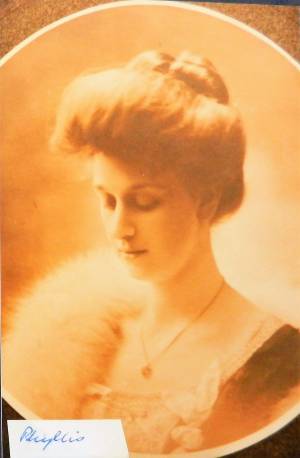Florette, Mabel, Ethel and Phyllis M-P
1. Florence (known as Florette) Elizabeth, was born at Bowen, Queensland on 1 January 18791) and baptised there by the Rev. M. Ross2); she died in Sydney on 12 July 1956.3) On 28 October 1896, the poet/novelist James Brunton Stephens wrote to her encouraging her to persevere with her poetry, but advising she defer publication.4) Prominent feminist Rose Scott also wrote to Florette encouraging her artistic talents.5) In the end, Florence decided on music, with a New Zealand paper reporting in 1906 that she planned to go to Paris for further study.6) In 1909 it was announced that she would be part of the Alys Bateman Concert Company to tour New Zealand the following year.7)
Like her sisters, she was educated at the elite school in the Eastern Suburbs of Sydney,Ascham.8)
In 1910, Florette married Sydney (Syd) Charles Edgar Herring; his sister Estella married Florette's step-uncle, Robert Sterling M-P. Sid Herring was an estate agent at Gladesville9) and distinguished himself during World War I, rising to the rank of Brigadier General.10) Florette followed him when he went overseas, with a number of their letters at the time surviving.11) She engaged in volunteer war work, with Max Barton writing in 1917 that he thought she was assisting (in what capacity it is not known) at a hospital in Harrow (England).12) She took her little daughter Diana with her overseas, first to Cairo then England.))
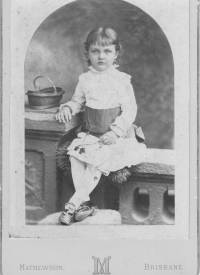 The photo is of the young Florette.13)
The photo is of the young Florette.13)
Florette strong-mindedness tended to be viewed with alarm, if not hostility, by the younger male members of the family. Nora M-P's nephew R.A. (Max) Barton was very sociable when on leave in London during World War I, but complained each time he felt duty-bound to visit Florette. That she campaigned (in the UK) for women's suffrage did not help him view her any more favourably, writing after one visit in 1917 that he'd 'listened to the success of her suffragette campaign in Ireland till I was sick … I was quite relieved to hear that Mrs Herring had, on receipt of report of above mentioned campaigns told her not to be a fool and to waste her time on such rubbish.' 14) Presumably 'Mrs Herring' was her mother-in-law. After the war, she continued to be viewed with trepidation partly because she was an energetic organiser of social events15) - the steely resolve evident in this childhood photo did not leave her! Her husband Syd appears more sympathetic with their wartime letters indicating that they enjoyed a happy marriage.
Syd and Florette's only child, a talented singer, was christened Florette Ruth Diana but always known as Diana (23 October 1911- 5 November 1993). In 1947, Diana married, secondly, Brian Fleming. They had two girls and a son Robert Brian Edgar Fleming (2 February 1951 - 5 June 2012). Brian Fleming documented his wife's family history; photos and documents from his collection have been used in this history.
For other photos, click on Florette
2. Mabel Penelope, M.A., Ch.M.(Sydney University) 10 September16) - 9 January 1932. She was born at Ipswich, perhaps on the property that, in 1880 at least, was owned by her grandfather TLM-P: Pullen, Moreton, Ipswich17). She was baptised at Ipswich by the Rev. Mr Heath.18) Her Sydney University records states that she went to school, presumably as a boarder, at Ascham.
A young, somewhat idealised Mabel (to get better copy) 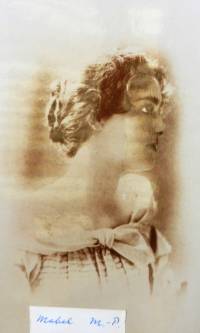
 19)
19)
An obituary published by the Women's College at the University of Sydney outlines her chequered academic career.20) She was the 41st student to enter the Women's College in 1899 while she studied for an Arts degree. She left after a year with second class honours in French. She returned to the University in 1903 to study medicine; it was a time when higher education was still controversial for women, and medicine particularly so. Medicine had a high failure rate and Mabel left, having only completed the third year of the course, in early 1907. She returned in 1911 in an attempt to finish, but left after a term. It is not known what she did then, though she was probably the 'Miss Murray-Prior' who unsuccessfully applied for the position of Superintendent at the Sydney Medical Mission in December 1911. She was not appointed because she was not medically qualified.21)
When World War I began in July 1914, Mabel was in Hong Kong. It is possible that she was on her way back from Europe to home, as a letter from Rosa Praed to Nora M-P in January 1914 states that Mabel was returning to Australia with Mary Bundock (Thomas de M. M-P's second wife).22) If so, war prompted her to return as she qualified in England in 1915 as a V.A.D. (Voluntary_Aid_Detachment) - as did her cousins Ruth M-P and probably Dorothy M-P. In December 1914, Ruth wrote that Mabel was accompanying her sister Florette to Europe: perhaps when Florette was trying to see her husband Sydney Herring who was on active duty.23). Mabel subsequently worked as a VAD in an unnamed English hospital. Dublin University was one of the few universities that admitted women, and she went there to complete her medical degree. After qualifying as a doctor, she was a medical resident for 6 months at the Royal Herbert Military Hospital in Woolwich, London then moved to Edinburgh Hospital, Scotland where she worked until mid-1919. In 1917, she was awarded a Doctor of Medicine at University of Edinburgh.24)
There is a letter dated 19 January 1915 [or is this a mistake for 1914?] from Ruth M-P to Rosa, saying that Mabel was engaged: if so, it was unofficial as another family member thought she was 'only fooling', and had booked to go to Japan, 'sans the man'.25) All her family appeared to have viewed Mabel as eccentric: her aunt Rosa Praed, for example, wrote to Ruth M-P after Mabel qualified as a physician: 'I suppose from Mabel's point of view it is a good thing, but I can't help feeling sorry for her patients. No doubt, however, the soldiers will adore her and she may put her best self into their ills.'26) Others were more forthright. Max Barton wrote to his mother in 1916 referring to Doris Kennedy, an Irish cousin: 'I did hear that Doris’s housekeeper expressed the opinion that Mabel M.P. was mad.'27) Nevertheless, the extended family remained close and when Mabel wrote to Nora M-P, her father's step-mother, it was to 'My dear Grandmother Nora'.28)
Mabel's cousin Dorothy (Dorothea M-P) wrote that Mabel visited Australia around 1921 for a visit: 'After that she travelled for some years before settling down to country life in England and in Ireland. She was a keen sportswoman and took great pleasure in hunting and in breeding dogs. In 1931 she was taking a course in gynaecology in Dublin. We saw her in Ireland before we left for Australia. She was then in poor health after a bad fall. Subsequently pneumonia set in and although news was cabled that she was recovering, there was a sudden relapse. She died in hospital. She was a brave, vivacious and warm-hearted woman, and we have found very many friends who mourn her passing.'29) The Daily Telegraph, when reporting her death, described her as 'a lady of brilliant intellect and vivid personality and had a good [medical] practice and a large circle of friends'.30) Mabel's support for the British Empire is evident by her 1924 Certificate of Fellowship of the British Empire Exhibition.31)
3. Thomas Bertram, b. 4 February 1883. See sidebar for separate entry.
4. Ethel Nora, 1 December 1884 - 1959. She was born at Moonbago Station, South Kennedy, Bully Creek, a station owned, at least in 1880, by her grandfather TLM-P.32). She was baptised at All Saints Church of England, Brisbane.33)
Ethel married William Royston (Roy) Butler in 190934) This photo is of her as a bride.35) 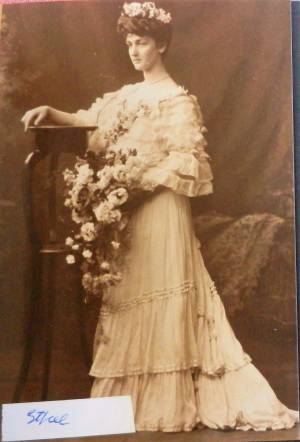
Ethel and Roy lived at 'Staghurst', Toogoolawah and had five children:
Bertram 1918-43, William (Bill) 1912-71, married Elizabeth (Betty) Munroe, and had 3 children;
Florence, 1914-63, married C.H.(Harry) Percy and had 2 children;
Douglas (1916-76); and
Pauline (25 June 1923 -??, married Ken Cunningham and had 3 children).36)
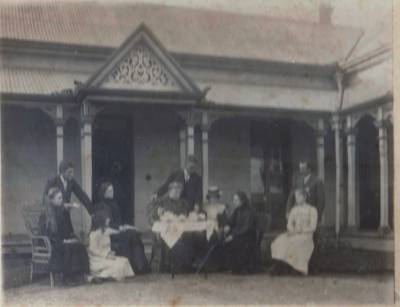 On the back of this photo is written that it shows a surprise party to wish Ethel a happy Xmas and glad new year, Xmas 1901. The old woman in the centre is understood to be Mary Bundock.37)
On the back of this photo is written that it shows a surprise party to wish Ethel a happy Xmas and glad new year, Xmas 1901. The old woman in the centre is understood to be Mary Bundock.37)
Ethel appears to have been musical like her sister Florette. She went to the trouble of binding her music together in a volume embossed with her name 'E. Butler'. On this sample page, she wrote her name and 'New York 1907', suggesting she obtained it there.  38)
38)
5. Phyllis Claudia 23 July 1886 - 1957. She was born at Maroon Station and baptised at All Saints Church of England, Brisbane by the Rev. M Robinson.39). She and Edgar Cannon McConnel married in 190940) and lived for most of their marriage on the McConnel family property Cressbrook, near Toogoolawah in south-west Queensland. Edgar McConnel was an outstanding horseman and helped train the Australian Light Horsemen during World War I.41) Noted anthropologist, Ursula McConnel, was Edgar McConnel's sister, and thus became Mary M-P's (Thomas de M. M-P's 2nd wife, as outlined below) step-niece: different generations of anthropologists of Aboriginal life connected to the one family. Phyllis and Edgar had 4 children: Duncan, Elizabeth, Margaret and Helen (married name Cook) McConnel. Duncan had three children and Helen Cook two.
 The two younger sisters.42) Phyllis when older.43)
The two younger sisters.42) Phyllis when older.43) 